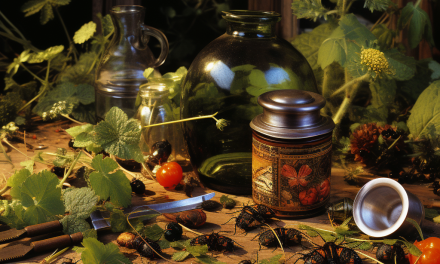Welcome to the Earwig-Free Zone! 🌱
Hello, lovely gardeners! It’s Gayle here, your go-to source for all things green and growing. I’ve been hearing from many of you about a tiny but troublesome garden invader: the earwig. These little critters can wreak havoc on your beautiful blooms and lush leaves, turning your garden into their personal buffet. So, today we’re diving deep into the world of earwig control. 🐛
Why You Should Care About Earwigs
Earwigs might be small, but they can cause big problems. From nibbling on your plants to invading your outdoor spaces, these pests can quickly become a gardener’s nightmare. That’s why it’s crucial to tackle the issue head-on, with effective strategies for both prevention and elimination.
What’s Coming Up
We’ll explore everything from understanding what earwigs actually are (and debunking some common myths) to natural and chemical solutions for keeping them at bay. Plus, I’ve got some fabulous pro-tips sprinkled throughout to give you that extra edge in your battle against these garden invaders.
So, grab your gardening gloves and let’s get started! 🌿
The Earwig Enigma: Unveiling the Mystery 🌼
The Real Deal About Earwigs
Earwigs are small, elongated insects with a pair of forceps-like pincers on their abdomen. Contrary to popular belief, they are not poisonous and they don’t crawl into people’s ears to lay eggs. However, they can be quite a nuisance in the garden, munching away on your beloved plants. Understanding their biology and behavior is the first step in effective earwig control.
Debunking Earwig Myths
There are plenty of myths surrounding earwigs. One common misconception is that they are dangerous to humans. In reality, earwigs are generally harmless and are more interested in your plants than in you. Another myth is that they are a sign of an unclean garden. Not true! Even the most well-kept gardens can face an earwig invasion.
Why the Fuss About Earwigs in the Garden?
You might be wondering, “Why should I even care about a few tiny insects?” Well, earwigs can cause significant damage to a wide variety of plants. They feed on leaves, flowers, and fruits, leaving behind a trail of destruction. If left unchecked, a small earwig problem can quickly escalate into a full-blown infestation, putting your hard work in jeopardy.
Pro-Tip: Know Your Enemy 🌟
The key to effective earwig control is understanding their habits. Earwigs are nocturnal creatures, which means they are most active at night. So, if you’re planning to catch them in the act, consider doing a garden inspection after sunset.
I hope this section gives you a better understanding of what you’re up against. Knowledge is power, especially when it comes to protecting your garden. 🌱
Spotting the Sneak Attack: Signs of an Earwig Infestation 🌿
The Telltale Signs in Your Garden
If you’ve been suspecting that earwigs have made a home in your garden, there are some clear signs to look out for. You might notice small, irregular holes in the leaves of your plants, or perhaps even some nibbled edges on your beautiful blooms. These are classic indicators that earwigs are feasting away.
The Unseen Culprits: Plant Damage
Earwigs are not just leaf munchers; they also love to snack on flowers and fruits. If you see petals that look shredded or fruits with irregular scarring, it’s time to take action. These little critters can be particularly fond of dahlias, zinnias, and marigolds, but they’re not too picky and will go for whatever is available.
The Night Owls: Earwig Activity After Dark
Earwigs are creatures of the night. If you’re brave enough to venture into your garden after the sun sets, you might catch them red-handed. They love damp, dark places, so be sure to check under pots, garden ornaments, and even your compost pile.
Pro-Tip: The Flashlight Trick 🌟
Want to catch these nocturnal nuisances in action? Equip yourself with a flashlight and do a quick garden tour about an hour or so after sunset. This is when they’re most active and you’re likely to spot them crawling around, giving you a better idea of the areas that need the most attention for earwig control.
There you have it, my green-thumbed friends! Knowing what to look for is half the battle. Once you’ve identified the signs of an earwig infestation, you’re well on your way to reclaiming your beautiful garden. 🌸
Nature’s Arsenal: Organic Ways to Show Earwigs the Exit 🌱
The Power of Diatomaceous Earth
One of my favorite natural remedies for earwig control is Diatomaceous Earth. This is a non-toxic powder made from fossilized marine phytoplankton. When earwigs crawl over it, the powder absorbs the oils from their exoskeleton, causing them to dehydrate and die. Simply sprinkle a thin layer around the base of your plants, and you’ll create a barrier that earwigs won’t want to cross.
Neem Oil: The Gardener’s Best Friend
Another fantastic natural option is Neem Oil. This organic insecticide disrupts the life cycle of earwigs, making it difficult for them to grow and reproduce. Mix a few drops of Neem Oil with water and spray it directly onto the leaves of affected plants. Not only does it deter earwigs, but it’s also effective against a variety of other pests.
DIY Traps: Your Secret Weapon
If you’re into DIY solutions, homemade traps can be incredibly effective. One simple method involves filling a shallow container with soy sauce and placing it in the affected areas of your garden. Earwigs are attracted to the scent and will crawl into the container, where they’ll get stuck and drown.
Pro-Tip: The Perfect Bait 🌟
When setting up your DIY traps, consider using a combination of soy sauce and a drop of fish oil or bacon grease. The extra scent makes the trap even more irresistible to earwigs, increasing your chances of catching these pesky invaders.
And there you have it! These natural solutions are not only effective but also kind to Mother Earth. 🌍 So, you can enjoy an earwig-free garden without harming the environment.
Chemical Warfare: When Nature Needs a Helping Hand 🌿💪
Insecticides: The Heavy Hitters
Sometimes, despite our best efforts, natural remedies just don’t cut it. That’s when it’s time to bring out the big guns: insecticides. Look for products specifically designed for earwig control, such as those containing pyrethroids. These chemicals target the nervous system of earwigs, effectively killing them on contact. Always remember to read and follow the manufacturer’s instructions for safe and effective use.
Chemical Baits: The Stealth Approach
If you’re not keen on spraying chemicals around your garden, chemical baits are a less invasive option. These baits come in granular form and can be scattered around the garden, especially in areas where you’ve noticed earwig activity. The earwigs are attracted to the bait, consume it, and eventually die. It’s a more discreet method but equally effective.
Safety First: Precautions to Take
When using chemical solutions, safety should be your top priority. Always wear gloves and a mask, and keep pets and children away from treated areas until the chemicals have dried.
Pro-Tip: Store Smart, Dispose Smarter 🌟
Proper storage and disposal of chemical products are crucial. Keep insecticides in their original containers, clearly labeled, and out of reach of children and pets. When it comes to disposal, don’t just throw the empty container in the trash. Many localities have special disposal programs for hazardous waste, so make sure to dispose of it responsibly.
Switching to chemical solutions is a big step, but sometimes it’s the most effective way to reclaim your garden from earwig invaders. Just remember, safety first! 🌱
Fortify Your Garden: Proactive Steps for Earwig Prevention 🌳🛡️
The Importance of Garden Hygiene
Keeping your garden clean is more than just an aesthetic choice; it’s a strategic move in earwig control. Earwigs love hiding in damp, cluttered spaces. By removing garden debris like fallen leaves, old mulch, and rotting wood, you eliminate their favorite hiding spots, making your garden less inviting to these pests.
Water Wisely: Timing is Everything
Earwigs are attracted to moisture, so how and when you water your plants can make a big difference. Opt for morning watering so the soil has time to dry out during the day. Avoid evening watering, as it creates the damp conditions that earwigs love.
Choose Your Plants Carefully
Believe it or not, the types of plants you choose can either attract or repel earwigs. Plants like calendula and marigolds are known to deter earwigs, while dahlias and zinnias might attract them.
Pro-Tip: The Power of Scent 🌟
Some plants, like lavender and rosemary, not only add beauty and aroma to your garden but also act as natural repellents for earwigs. Consider planting these around the border of your garden to create a fragrant barrier against these pesky invaders.
Taking preventive measures can save you a lot of time and effort in the long run. A little bit of planning and proactive care can go a long way in keeping your garden earwig-free. 🌱
Keep Watch: The Art of Earwig Vigilance 🌿🔍
Regular Inspections: Your First Line of Defense
Consistency is key when it comes to earwig control. Make it a habit to inspect your garden regularly for signs of earwig activity. Check under pots, garden ornaments, and especially in damp, shaded areas. The sooner you spot an infestation, the easier it will be to manage.
When to Call in the Pros
Sometimes, despite our best efforts, an earwig problem can get out of hand. If you’ve tried multiple methods and are still seeing significant damage, it might be time to consult a professional. Pest control services have the expertise and equipment to deal with severe infestations effectively.
Long-Term Strategies for a Healthy Garden
Earwig control isn’t a one-time event; it’s an ongoing process. Consider integrating earwig prevention into your regular garden maintenance. This could mean periodic applications of natural or chemical treatments, regular cleaning of garden debris, and seasonal inspections.
Pro-Tip: Keep a Garden Journal 🌟
One of the best ways to monitor your garden’s health is by keeping a journal. Note down when you apply treatments, when you spot earwigs, and any changes in plant health. This will not only help you identify patterns but also make it easier to consult with professionals, should the need arise.
Consistent monitoring and maintenance are your best allies in keeping your garden beautiful and earwig-free. A proactive approach today saves you from a bigger headache tomorrow. 🌱
The Final Sprout: Wrapping Up Your Earwig Battle 🌱🎉
Summary of Your Garden’s New Best Friends
We’ve covered a lot of ground today, from understanding the biology of earwigs to various methods for earwig control, both natural and chemical. We’ve also delved into preventive measures and the importance of ongoing maintenance to keep these pesky critters at bay.
I want to thank you for joining me on this journey to reclaim our gardens. Remember, gardening is not just about the destination; it’s about the journey. Each challenge we face, like dealing with earwigs, is an opportunity to grow and learn. So don’t be disheartened if you’re facing an earwig invasion; consider it a rite of passage in your gardening adventure.
I’d love to hear about your own experiences with earwig control. Have you tried any of the methods we discussed? Do you have any tips or tricks of your own? Your insights could be invaluable to other gardeners facing the same issue.
Join Our Garden Community 🌟
If you haven’t already, consider joining our online garden community. It’s a fantastic place to share tips, ask questions, and get support from fellow garden enthusiasts. Plus, you’ll be the first to know about new blog posts, tutorials, and other resources to help you on your gardening journey.
Your garden is a labor of love, and every challenge is an opportunity for growth—both for you and your plants. Here’s to happy, healthy, and earwig-free gardening! 🌱🌸
Amazon and the Amazon logo are trademarks of Amazon.com, Inc, or its affiliates.AMAZON AFFILIATE DISCLOSURE The Garden Whisperer Tips blog is a participant in the Amazon Services LLC Associates Program, an affiliate advertising program designed to provide a means for sites to earn advertising fees by advertising and linking to Amazon.com. As an Amazon Associate, we earn from qualifying purchases. Some of the links on this blog are affiliate links, and if you go through them to make a purchase, we will earn a commission at no extra cost to you. AFFILIATE MARKETING AND ADVERTISEMENT TRANSPARENCY At Garden Whisperer Tips, we believe in full transparency with our readers. We participate in multiple affiliate marketing programs, and some of the links on this blog may be affiliate links. This means we may earn a commission if you click on the link or make a purchase using the link. We also host advertisements on our blog, which helps us generate revenue. Rest assured, our editorial content is not influenced by advertisers or affiliate partnerships.





